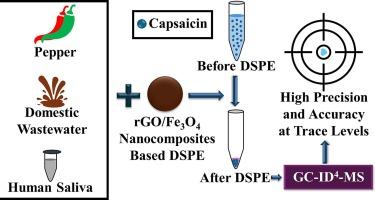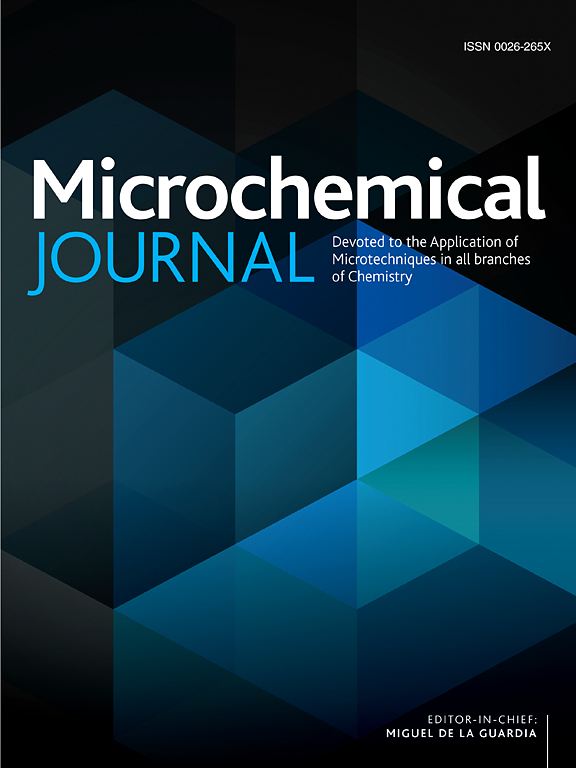分散固相萃取-四同位素稀释-质谱联用GC-MS系统准确、灵敏地定量辣椒、生活废水和人唾液样品中的辣椒素
IF 4.9
2区 化学
Q1 CHEMISTRY, ANALYTICAL
引用次数: 0
摘要
本研究建立了还原氧化石墨烯/Fe3O4 (rGO/Fe3O4)纳米复合材料分散固相萃取(DSPE) -气相色谱-质谱(GC-MS)法测定生活废水(DW)、辣椒(PP)和人唾液(HS)样品中的辣椒素。对影响预富集系数的各重要参数进行了优化,得到了高信噪比的分析物。通过优化研究,以辣椒素为标准水溶液,评价了DSPE-GC-MS系统的分析性能。检测限(LOD)为0.54µg/kg,定量限(LOQ)为1.80µg/kg,动态范围为2.66 ~ 487.35µg/kg。在最佳实验条件下,对添加的DW、PP和HS样品进行了回收率研究,通过矩阵匹配校准策略,回收率在52.6% ~ 183.6%之间。采用ID4策略后,DW、PP和HS样品的加标回收率分别为98.2% ~ 99.3%、99.7% ~ 100.7%和99.4% ~ 99.8%。DSPE-GC-ID4-MS法测定Sivri (S)-PP、Kıl (K)-PP和samandaku (SA)-PP样品中辣椒素含量分别为309.5±11.8 mg/kg、873.7±26.7 mg/kg和165.3±5.1 mg/kg。因此,成功地将四重同位素稀释(ID4)策略与DSPE-GC-MS方法相结合,提高了所建立的DSPE-GC-MS方法的准确度和精密度。本文章由计算机程序翻译,如有差异,请以英文原文为准。

Dispersive solid phase extraction and quadruple isotope dilution–mass spectrometry combination for the accurate and sensitive quantification of capsaicin in pepper, domestic wastewater and human saliva samples by GC–MS system
In the presented study, reduced graphene oxide/Fe3O4 (rGO/Fe3O4) nanocomposites based dispersive solid phase extraction (DSPE) – gas chromatography–mass spectrometry (GC–MS) method was developed for the determination of capsaicin in domestic wastewater (DW), pepper (PP) and human saliva (HS) samples. All important parameters of the DSPE method affected the preconcentration factor were carefully optimized to achieve high signal to noise ratio for the analyte. After the optimization studies, the system analytical performance of DSPE-GC–MS system was evaluated using the aqueous standard solution of capsaicin. Limit of detection (LOD), limit of quantitation (LOQ) and dynamic range were figured out to be 0.54 µg/kg, 1.80 µg/kg and 2.66 – 487.35 µg/kg, respectively. Under the optimum experimental conditions, recovery studies were conducted with the spiked DW, PP and HS samples, and percent recovery results were recorded between 52.6 % and 183.6 % via matrix matching calibration strategy. After the implementation of ID4 strategy, percent recovery results for the spiked DW, PP and HS samples were calculated as 98.2 %–99.3 %, 99.7 %–100.7 % and 99.4 %–99.8 %, respectively. In addition, capsaicin content in Sivri (S)-PP, Kıl (K)-PP and Samandağ (SA)-PP samples were found to be 309.5 ± 11.8 mg/kg, 873.7 ± 26.7 mg/kg and 165.3 ± 5.1 mg/kg via DSPE-GC-ID4-MS method, respectively. As a result, the combination of quadruple isotope dilution (ID4) strategy and the DSPE-GC–MS method were successfully performed to boost the accuracy and precision of developed DSPE-GC–MS method.
求助全文
通过发布文献求助,成功后即可免费获取论文全文。
去求助
来源期刊

Microchemical Journal
化学-分析化学
CiteScore
8.70
自引率
8.30%
发文量
1131
审稿时长
1.9 months
期刊介绍:
The Microchemical Journal is a peer reviewed journal devoted to all aspects and phases of analytical chemistry and chemical analysis. The Microchemical Journal publishes articles which are at the forefront of modern analytical chemistry and cover innovations in the techniques to the finest possible limits. This includes fundamental aspects, instrumentation, new developments, innovative and novel methods and applications including environmental and clinical field.
Traditional classical analytical methods such as spectrophotometry and titrimetry as well as established instrumentation methods such as flame and graphite furnace atomic absorption spectrometry, gas chromatography, and modified glassy or carbon electrode electrochemical methods will be considered, provided they show significant improvements and novelty compared to the established methods.
 求助内容:
求助内容: 应助结果提醒方式:
应助结果提醒方式:


